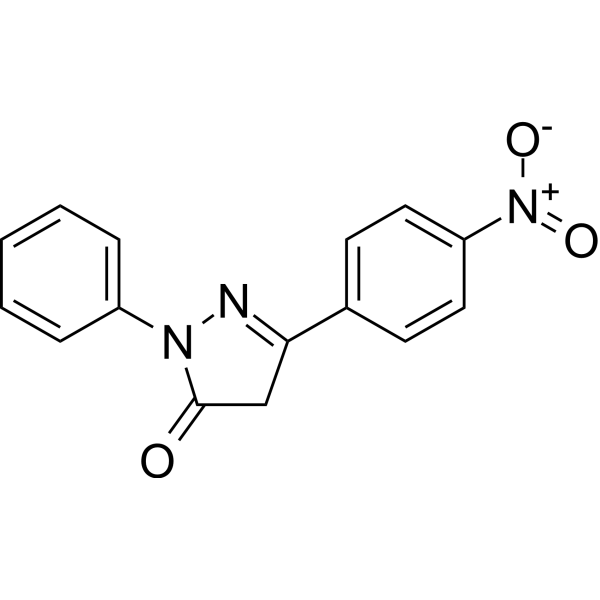Physicochemical Properties
| Molecular Formula | C15H11N3O3 |
| Molecular Weight | 281.27 |
| Exact Mass | 281.08 |
| Elemental Analysis | C, 64.05; H, 3.94; N, 14.94; O, 17.06 |
| CAS # | 34320-83-7 |
| PubChem CID | 2750328 |
| Appearance | White to yellow solid powder |
| Density | 1.4±0.1 g/cm3 |
| Boiling Point | 445.1±47.0 °C at 760 mmHg |
| Flash Point | 223.0±29.3 °C |
| Vapour Pressure | 0.0±1.1 mmHg at 25°C |
| Index of Refraction | 1.674 |
| LogP | 1.92 |
| Hydrogen Bond Donor Count | 0 |
| Hydrogen Bond Acceptor Count | 4 |
| Rotatable Bond Count | 2 |
| Heavy Atom Count | 21 |
| Complexity | 444 |
| Defined Atom Stereocenter Count | 0 |
| SMILES | O=C1CC(C2C=CC(=CC=2)[N+](=O)[O-])=NN1C1C=CC=CC=1 |
| InChi Key | FDAVFKZPGQEGDX-UHFFFAOYSA-N |
| InChi Code | InChI=1S/C15H11N3O3/c19-15-10-14(11-6-8-13(9-7-11)18(20)21)16-17(15)12-4-2-1-3-5-12/h1-9H,10H2 |
| Chemical Name | 5-(4-nitrophenyl)-2-phenyl-4H-pyrazol-3-one |
| Synonyms | TCS PRP INHIBITOR 13; 34320-83-7; 5-(4-nitrophenyl)-2-phenyl-4H-pyrazol-3-one; 3-(4-nitrophenyl)-1-phenyl-1H-pyrazol-5(4H)-one; 3-(4-Nitrophenyl)-1-phenyl-2-pyrazolin-5-one; 2,4-DIHYDRO-5-(4-NITROPHENYL)-2-PHENYL-3H-PYRAZOL-3-ONE; 5-(4-nitrophenyl)-2-phenyl-2,4-dihydro-3H-pyrazol-3-one; ST51035799; |
| HS Tariff Code | 2934.99.9001 |
| Storage |
Powder-20°C 3 years 4°C 2 years In solvent -80°C 6 months -20°C 1 month |
| Shipping Condition | Room temperature (This product is stable at ambient temperature for a few days during ordinary shipping and time spent in Customs) |
Biological Activity
| Targets | IC50: 3 nM (PrPC in ScN2a and F3 cells)[1] |
| ln Vitro | TCS PrP Inhibitor 13 (0~500 μM; Schwannoma cells) dramatically raises the expression of cleaved caspase-3 while dramatically lowering levels of total ERK1/2, pAKT, total FAK, Cyclin D1, and PrPC. The overall number of cells and the number of proliferating, Ki67-positive cells are both dramatically decreased by TCS PrP Inhibitor 13 (Schwannoma cells)[2]. |
| Cell Assay | To find effective antiprion compounds, researchers synthesized and evaluated various pyrazolone derivatives. Seven of 19 compounds showed inhibition of PrP-res accumulation and the remarkably active compound 13 showed an IC50 value of 3 nM in both ScN2a and F3 cell lines. Findings from studies on physicochemical and biochemical properties suggest that the action mechanism of these compounds does not correlate with any antioxidant activities, any of hydroxyl radical scavenging activities, or any SOD-like activities.[1] |
| References |
[1]. Kimata A, et al. New series of antiprion compounds: pyrazolone derivatives have the potent activity of inhibiting protease-resistant prion protein accumulation [published correction appears in J Med Chem. 2008 Mar 13;51(5):1503]. J Med Chem. 2007;50(21):5053-5056. [2]. Provenzano L, et al. Cellular prion protein (PrPC) in the development of Merlin-deficient tumours. Oncogene. 2017;36(44):6132-6142. |
| Additional Infomation | Loss of function mutations in the neurofibromatosis Type 2 (NF2) gene, coding for a tumour suppressor, Merlin, cause multiple tumours of the nervous system such as schwannomas, meningiomas and ependymomas. These tumours may occur sporadically or as part of the hereditary condition neurofibromatosis Type 2 (NF2). Current treatment is confined to (radio) surgery and no targeted drug therapies exist. NF2 mutations and/or Merlin inactivation are also seen in other cancers including some mesothelioma, breast cancer, colorectal carcinoma, melanoma and glioblastoma. To study the relationship between Merlin deficiency and tumourigenesis, we have developed an in vitro model comprising human primary schwannoma cells, the most common Merlin-deficient tumour and the hallmark for NF2. Using this model, we show increased expression of cellular prion protein (PrPC) in schwannoma cells and tissues. In addition, a strong overexpression of PrPC is observed in human Merlin-deficient mesothelioma cell line TRA and in human Merlin-deficient meningiomas. PrPC contributes to increased proliferation, cell-matrix adhesion and survival in schwannoma cells acting via 37/67 kDa non-integrin laminin receptor (LR/37/67 kDa) and downstream ERK1/2, PI3K/AKT and FAK signalling pathways. PrPC protein is also strongly released from schwannoma cells via exosomes and as a free peptide suggesting that it may act in an autocrine and/or paracrine manner. We suggest that PrPC and its interactor, LR/37/67 kDa, could be potential therapeutic targets for schwannomas and other Merlin-deficient tumours.[2] |
Solubility Data
| Solubility (In Vitro) | DMSO : 100 mg/mL (355.53 mM) |
| Solubility (In Vivo) |
Solubility in Formulation 1: ≥ 2.5 mg/mL (8.89 mM) (saturation unknown) in 10% DMSO + 40% PEG300 +5% Tween-80 + 45% Saline (add these co-solvents sequentially from left to right, and one by one), clear solution. For example, if 1 mL of working solution is to be prepared, you can add 100 μL of 25.0 mg/mL clear DMSO stock solution to 400 μL PEG300 and mix evenly; then add 50 μL Tween-80 + to the above solution and mix evenly; then add 450 μL normal saline to adjust the volume to 1 mL. Preparation of saline: Dissolve 0.9 g of sodium chloride in 100 mL ddH₂ O to obtain a clear solution. (Please use freshly prepared in vivo formulations for optimal results.) |
| Preparing Stock Solutions | 1 mg | 5 mg | 10 mg | |
| 1 mM | 3.5553 mL | 17.7765 mL | 35.5530 mL | |
| 5 mM | 0.7111 mL | 3.5553 mL | 7.1106 mL | |
| 10 mM | 0.3555 mL | 1.7777 mL | 3.5553 mL |
